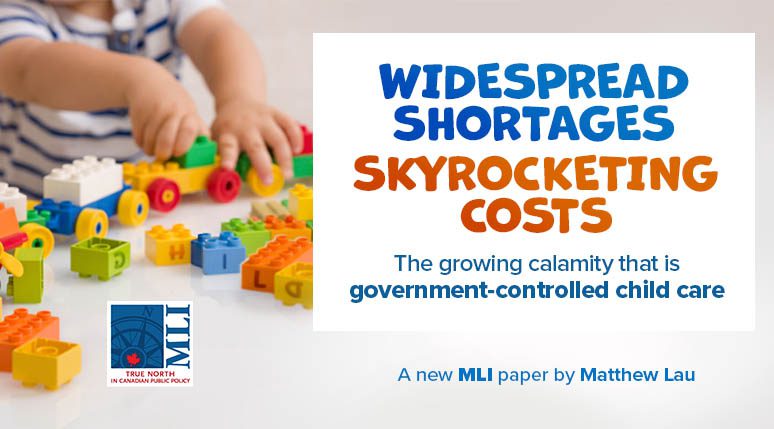By Matthew Lau
April 17, 2024
Executive Summary
In its 2021 federal budget, the Liberal government introduced its national child care plan. It proposed up to $30 billion in new spending over five years, and then $9.2 billion annually on an ongoing basis to establish national government-regulated child care at an average out-of-pocket cost to families of $10 per day. The stated objective was to build a high-quality, affordable, and accessible child care system across Canada.
The early evidence on the effect of the government program is not encouraging. Despite billions of dollars in new government spending, in 2023 there were fewer children in child care arrangements of any sort than before the pandemic in 2019. Centre-based child care attendance was up, but this was offset by a larger decline in other forms of child care, including home-based child care businesses.
Specifically, only 56.1 percent of children aged 0 to 5 years were in child care in 2023, down from 59.9 percent in 2019 – a decline of 118,000 children attending child care. Child care attendance was flat or down in every province in Canada, a telling sign that there are problems with the national program and not simply with local implementation.
The reduction in child care attendance does not reflect declining demand. Out of families using child care, the percentage who reported difficulty finding that care rose significant ly to 46.4 percent in 2023 from 36.4 percent in 2019, with the reported difficulty increasing in every province. The fact that finding child care has become more difficult even though fewer people are using it is clear evidence of declining accessibility.
There is also abundant evidence of a heavy administrative burden on top of the billions of dollars in annual taxes needed to fund the program, suggesting that even if out of-pocket fees fall with government subsidies, the all-in costs of providing child care are up. For example, in Ontario, a government memo noted in 2023 that child care funding to municipalities would include $26 million for administration of the federal program, $85.5 million in “one-time” payments for administration, plus $4.5 million for the administration of other grants.
Significant administrative costs are also downloaded to providers themselves, not only in Ontario, but in other provinces. Krystal Churcher, chair of the Association of Alberta Childcare Entrepreneurs, estimates that for her business, the government-imposed administrative burden works out to about $28 per child per month, plus an annual audit fee of $30,000. Estimates show that between the additional administrative costs and the negative revenue effects of price controls, the typical child care business in Alberta could expect to see half its earnings wiped out.
Unsurprisingly, given the dismal statistics on child care attendance and availability as well as the severe financial burdens imposed on operators by government, stories of child care crises and shortages are widespread in Canada. In Vancouver, there is a shortage of 15,000 spaces for children up to age 12. Toronto is projected to fall well short of its child care space targets, and the Financial Accountability Office of Ontario warned in 2022 that even if the provincial government hits its targets to create 375,000 child care spaces by 2026, there would still be a massive shortfall of 227,000 spaces.
News stories report that since the roll out of the government child care program in Ontario, wait lists have expanded by 115 percent in Waterloo, 76 percent in the Niagara region, and 41 percent in Ottawa. In Coquitlam, British Columbia, some parents are waiting three years for child care spots; on the other side of the country in Prince Edward Island, the wait list for child care spaces has ballooned by about 65 percent in the last four years.
The inaccessibility of child care is exacerbated by the inflexibility imposed on families. Subsidizing formal, government-regulated options at the expense of alternatives that many families prefer is a severely deleterious substitution of political judgment in place of parental judgment, and this is exacerbated by discrimination within the government-regulated sector against for-profit private sector operators. Quality and choice have both suffered as a result.
Lastly, it is telling that when the national child care plan was introduced, much of the focus was not actually on caring for children, but on changing the nature of women’s work to the kind that shows up in GDP statistics instead of the kind that takes place at home. The early evidence, however, is that national child care has failed to achieve its goals with respect to female employment and labour participation. And even if this goal were to be achieved, it does not mean the program is beneficial: it simply means the government has distorted the nature of women’s work versus what women would have ordinarily chosen.
If Canadian families are struggling with the cost of child care, the way to properly and directly address this is to increase their purchasing power. This was the solution endorsed by Canadians in 2006 and implemented by the federal Conservative government, which gave money to parents in the form of the Universal Canada Child Benefit and let them decide how best to use it to improve their family’s well-being and care for their children. The government takeover of the child care sector is entirely unjustified, and the results have been calamitous
Read the full paper here:







